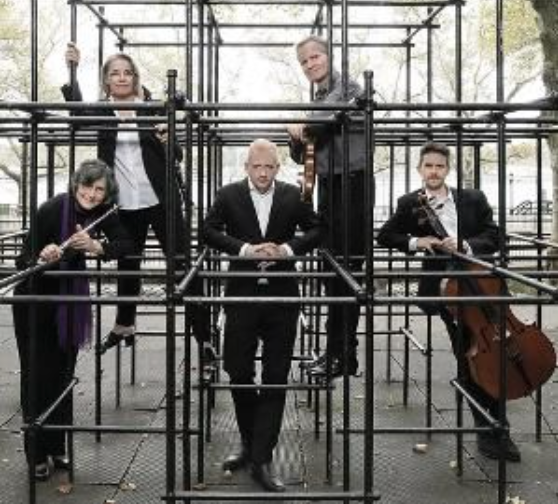Da Capo Chamber Players Women Composers plus a new work by David Sanford in Review
Patricia Spencer, flute and alto flute; Marianne Glythfeldt, clarinet and bass clarinet; Curtis Macomber, violin; Chris Gross, cello; Steven Beck, piano
Guest Artists: Yoshi Weinberg, flute; Hannah Levinson, viola; Michael Lipsey, percussion; James Baker, conductor
Tenri Cultural Institute, New York, NY
February 26, 2023
I wish I could split this review of the Da Capo Chamber Players’ 51st Season into two parts—I shall explain in a moment. Their 50th season was spread over several years due to you-know-what. But think about a fifty-year legacy rich with commissions and a fierce desire to present works by living composers in addition to a few canonic works.
When you attend a concert by Da Capo, you hear transcendent virtuosity, including stunning extended techniques, as we did on this occasion. You know that each time you hear a performance you are hearing the finest possible rendition—as if it were a ready-to-release CD. Da Capo’s survival is largely due to the unwavering labor of its remaining founding member, flutist Patricia Spencer.
Three of the four works on this occasion were by women, and three of the four works by living composers- two of whom were present. However, and here’s where I must return to my above comment, I sat in the intimate gallery space of the Tenri Cultural Center, and aside from my admiration for the playing, I was left absolutely cold. How I longed for just one melodic phrase with some expansion, some yearning, or any sustained mood. Today’s composers seem more preoccupied with innovations in sonority and rhythmic dislocation—two important elements of music to be sure, but not the whole picture. The head/heart ratio, as I call it, is out of whack.
Bach’s Die Kunst der Fuge (The Art of Fugue), the work I have spent the most time living with in my career, is one of the most abstruse treatises on counterpoint ever conceived by a human, yet it is at the same time a gripping, emotionally moving statement.
The concert began with Barbara White’s Learning to See, her musical response to four prominent 20th century visual artists: Tinguely, Brancusi, Hesse, and Johns, with their technical preoccupations translated into her music. The title of the first section (after Tinguely) with its phrase “junk heap” did not bode well for me, though I was able to appreciate the fine shades of instrumental blending the players achieved. Brancusi’s music (Bird) formed an alternating episode between the others, similar to a rondo. This was the only work in which Patricia Spencer played—she generously gave the rest of the evening to a young colleague, Yoshi Weinberg.
Next was, for me, the most successful work of the evening, Eleanor Hovda’s Ariadne Music (1984), in which one could imagine the mounting terror of being trapped in a labyrinth with a monster, as represented by wisps of sonority that grew to a shattering climax over an excruciating amount of time, then subsided to the point at which it began. This work was conducted by James Baker.
After intermission, a brief hard-to-hear interview was conducted by David Bridges of the Composers Now initiative with Barbara White and David Sanford. Folks, if you’re not going to use microphones, please project and enunciate. They discussed how the ensembles they work with may, or may not, influence their composing, and they talked about the importance of quotation (transformed, of course) to their process.
Then came the world premiere: David Sanford’s time isn’t holding us (2023), leaning on his great knowledge of jazz and “unstable” (as he calls it) music from the 1970s, including Jimi Hendrix, George Crumb, Miles Davis, and Charles Mingus, all demonically sampled and transformed. Among the new techniques I observed (perhaps I need to get out more often!), was the xylophone being brushed with string bows. I must single out pianist Steven Beck for his tremendous musicianship and versatility.
In conclusion, Da Capo offered Belinda Reynolds’ light hearted coming around… (1995), a sort of musical portrayal of a Californian working in New York City for a few years, then returning to her true homeland. Particularly enjoyable was a “fractured waltz” in the middle of the work, never staying in 3/4 too long.
I have every confidence that Da Capo will continue far into the future—and I hope they are, in fact, able to get a younger generation interested in placing and keeping groundbreaking works in the repertoire.

